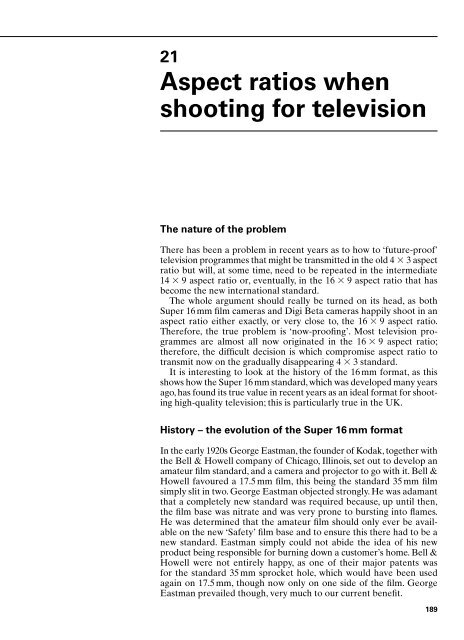1 The Director of Photography – an overview
1 The Director of Photography – an overview
1 The Director of Photography – an overview
Create successful ePaper yourself
Turn your PDF publications into a flip-book with our unique Google optimized e-Paper software.
21<br />
Aspect ratios when<br />
shooting for television<br />
<strong>The</strong> nature <strong>of</strong> the problem<br />
<strong>The</strong>re has been a problem in recent years as to how to ‘future-pro<strong>of</strong>’<br />
television programmes that might be tr<strong>an</strong>smitted in the old 4 � 3 aspect<br />
ratio but will, at some time, need to be repeated in the intermediate<br />
14 � 9 aspect ratio or, eventually, in the 16 � 9 aspect ratio that has<br />
become the new international st<strong>an</strong>dard.<br />
<strong>The</strong> whole argument should really be turned on its head, as both<br />
Super 16 mm film cameras <strong>an</strong>d Digi Beta cameras happily shoot in <strong>an</strong><br />
aspect ratio either exactly, or very close to, the 16 � 9 aspect ratio.<br />
<strong>The</strong>refore, the true problem is ‘now-pro<strong>of</strong>ing’. Most television programmes<br />
are almost all now originated in the 16 � 9 aspect ratio;<br />
therefore, the difficult decision is which compromise aspect ratio to<br />
tr<strong>an</strong>smit now on the gradually disappearing 4 � 3 st<strong>an</strong>dard.<br />
It is interesting to look at the history <strong>of</strong> the 16 mm format, as this<br />
shows how the Super 16 mm st<strong>an</strong>dard, which was developed m<strong>an</strong>y years<br />
ago, has found its true value in recent years as <strong>an</strong> ideal format for shooting<br />
high-quality television; this is particularly true in the UK.<br />
History <strong>–</strong> the evolution <strong>of</strong> the Super 16 mm format<br />
In the early 1920s George Eastm<strong>an</strong>, the founder <strong>of</strong> Kodak, together with<br />
the Bell & Howell comp<strong>an</strong>y <strong>of</strong> Chicago, Illinois, set out to develop <strong>an</strong><br />
amateur film st<strong>an</strong>dard, <strong>an</strong>d a camera <strong>an</strong>d projector to go with it. Bell &<br />
Howell favoured a 17.5 mm film, this being the st<strong>an</strong>dard 35 mm film<br />
simply slit in two. George Eastm<strong>an</strong> objected strongly. He was adam<strong>an</strong>t<br />
that a completely new st<strong>an</strong>dard was required because, up until then,<br />
the film base was nitrate <strong>an</strong>d was very prone to bursting into flames.<br />
He was determined that the amateur film should only ever be available<br />
on the new ‘Safety’ film base <strong>an</strong>d to ensure this there had to be a<br />
new st<strong>an</strong>dard. Eastm<strong>an</strong> simply could not abide the idea <strong>of</strong> his new<br />
product being responsible for burning down a customer’s home. Bell &<br />
Howell were not entirely happy, as one <strong>of</strong> their major patents was<br />
for the st<strong>an</strong>dard 35 mm sprocket hole, which would have been used<br />
again on 17.5 mm, though now only on one side <strong>of</strong> the film. George<br />
Eastm<strong>an</strong> prevailed though, very much to our current benefit.<br />
189

















